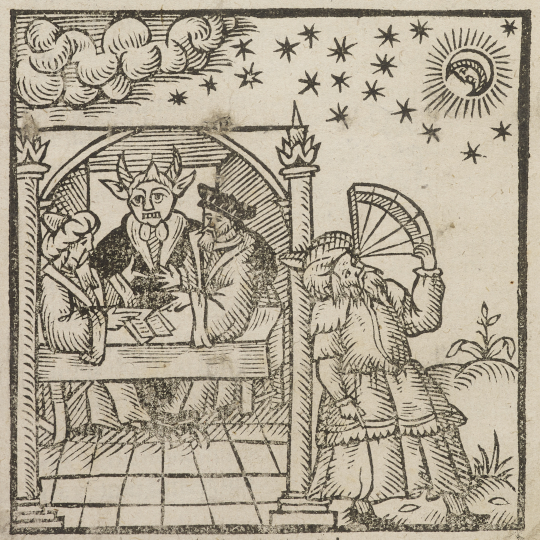
Image of astrologers at work in a mock prognostication owned by Simon Forman. John Cypriano, A moste strange and wonderfull prophesie upon this troublesome worlde (1595). Bodleian Library, Ashmole 546. Copyright Bodleian Library, University of Oxford, 2018.
Astrology is one of the most enduring intellectual traditions in history. It began in ancient Babylonia, reached its height in the Renaissance, and, though its credibility declined from around 1600, its practice has continued to the present day.
Its principles are self-evident: there is a connection between the stars in the sky and life on earth. The nature of this influence, however, has been the subject of intellectual scrutiny since Classical antiquity, when the science of the stars became the subject of philosophical exposition. Day-by-day, early modern astrologers, like their intellectual siblings astronomers and doctors, were more concerned with successful techniques than causal principles. They counselled rulers about when to deploy an army or take a bath, advised the Church on the dates of the ritual calendar, diagnosed diseases at the bedsides of the nobility and in drop-in clinics, identified thieves and located buried treasure, wrote histories of creation and biographies of famous people, and published almanacs that forecast the weather and predicted, in coded language about the qualities of the planets and their relations, the death of kings and queens. Some astrologers made a lot of money, others died in disgrace. They traded, with varying degrees of learning and expertise, in the ability to compute the location of the planetary bodies at a given time, and to read these stellar maps for signs of a person’s character and wellbeing, the fortunes of a city, and the fate of a nation. Some were renowned astronomers and mathematicians. Others were subtle diagnosticians, able to read the natural and social causes of disease. All were open to accusations of deception and fraud, whether explained as human weakness or demonic allegiances.
By 1600, when Simon Forman and Richard Napier were practising, political tracts rehearsed well-trodden debates about whether astrology was consonant with Christian definitions of free will, and experimental philosophers questioned the limits of astral influences. These debates often centred on whether astrology was ‘natural’ or ‘judicial’. Natural astrology was defined in relation to astronomy: astronomy was the science of the motion of the stars, astrology the science of the effects of stellar beams, like the rays of the sun, on terrestrial bodies. A conjunction of malevolent planets or a comet, for instance, could cause wars, famines, plagues, or earthquakes. Accordingly, the science of the stars was as often used to chronicle the past as to predict the future.
The techniques of judicial astrology had more specific, individual applications. Nativities, what we today call horoscopes, were computed to understand a person’s character and fortune. Elections were used to decide a favourable moment for a particular course of action such as embarking on a journey, consummating a marriage, or laying the foundation stone for a building. Interrogations were techniques, such as horary astrology, favoured by Forman and Napier, to answer particular questions about a person’s health or other aspects of their lives.
In the thirteenth century, physicians began to study astrology as part of their university training. By the fifteenth century, the ability to judge critical days and to analyse a patient’s urine were the mark of an accomplished physician. Urine and other bodily products showed signs of the inward workings of the body, while an understanding of the moments of crisis in an illness, usually the seventh, fourteenth, and twentieth days, after which a patient usually died or recovered, ensured that the practitioner timed his treatments auspiciously. Through the sixteenth and seventeenth centuries, some physicians began to dismiss these practices as conjectural, seeking instead to identify other, observable signs of disease and environmental factors. But astrological medicine, whether as a language of correspondences or a causal system, had enduring appeal for patients and practitioners for centuries to come.
Simon Forman’s and Richard Napier’s astrology
The astrology that Forman and Napier practised was judicial rather than natural. They were interested less in predicting the critical days of an illness, or attending to the physical effects of the moon on the human body, and more on drawing up charts of the heavens at the moment of a particular event, or the beginning of a process, in order to understand its nature and likely outcome. These were interrogations rather than medical astrology.
Sometimes the event in question was a birth, sometimes the beginning of an illness (a decumbiture) or an episode within an illness; sometimes it was a marriage, or a death, or the beginning of a journey. By a considerable margin, however, the majority of the entries in Forman’s and Napier’s casebooks — some 95% — concerned the moment at which a client consulting the astrologer asked a question. This was horary astrology: a type of interrogation in which the practitioner drew up an astrological chart for the time at which a question reached him, whether asked in person or received by letter. For the judgment he reached to be true, the person asking the question (the querent) must genuinely and honestly want at that moment to know the answer; Forman gave advice on how to tell from the astrological figure whether that had been the case.
The production of a horary entry seems to have been the astrologers’ first response on being consulted. Sometimes that sufficed; on other occasions the horary entry would be accompanied by a nativity, or a decumbiture, or an election, or an interrogation for some other event connected to the client’s problem. In a few cases, Napier in particular worried enough about the right moment for a horary entry that he also drew up figures for the times at which messengers had set off to meet him, or the moment at which he had written out the entry if it was not the same as the time he received the message. If summoned to a patient’s bedside, he might pay attention to both the receipt of the summons and the moment of his arrival. Napier often recorded, and even drew up interrogations for, the moment at which a particular treatment was applied. Forman and Napier both cross-referenced entries when someone consulted repeatedly about the same problem, so that they could check back and trace the history of the illness and of the consultations themselves. In similar fashion, they used the casebooks as diaries of their own lives, noting events and casting charts for significant moments.
Once the practitioner knew the date and time for which he was to draw up a chart, he looked up the positions of the planets in an ephemeris, and used a table of houses to calculate the locations of the constellations. The astrology that Forman practised, and taught Napier, was in some respects a curious blend of precision and imprecision. On the one hand, while they calculated the positions of the signs of the zodiac as closely as possible to the time of the event, they typically used the positions of the planets at noon, no matter how many hours distant that was. On the other hand, Napier in particular can be found checking the details of his figures in more than one ephemeris and noting the divergences between them (see for instance CASE20187; CASE12464; CASE51584). For more technical detail on how these charts were constructed, download Astrology in the casebooks.
The next step was to interpret the positions of the planets - in terms of the figure itself, in terms of the constellations of the zodiac, and in terms of each other. Forman laid out in considerable detail what he believed could be inferred from an astrological chart in The Astrologicalle Judgmentes of phisick and other Questions. He held the examination of urine to be an unreliable diagnostic tool, and he mistrusted patients’ own statements about their health. Astrology, Forman believed, could tell him everything he needed to know to understand what was wrong with someone, to predict what the outcome would be, and to effect a cure if that were possible. Napier, on the other hand, on the evidence of his judgments, seems to have paid serious attention to urine brought to him, and recorded circumstantial details of his patients’ lives and problems that could not have been read in the stars — including people’s names. He drew on this range of signs, combining the examination of urine with his querents’ testimony and the careful interpretation of astrological charts, to diagnose his patients and to decide on the best treatment.
Further reading
- Dooley, Brendan (ed.) (2014) A Companion to Astrology in the Renaissance, Leiden: Brill.
- MacDonald, Michael (1996) ‘The Career of Astrological Medicine in England’, in Religio Medici: Medicine and Religion in Seventeenth Century England, ed. Ole Grell and Andrew Cunningham, Aldershot: Ashgate, 62–90.
- Maxwell-Stuart, P.G. (2010) Astrology from Ancient Babylon to the Present, Chalford: Amberley.
- Rutkin, H. Darrel (2006) ‘Astrology’, in The Cambridge History of Science, Volume 3: Early Modern Science, ed. Katharine Park and Lorraine Daston, Cambridge: Cambridge University Press, 542–61.


